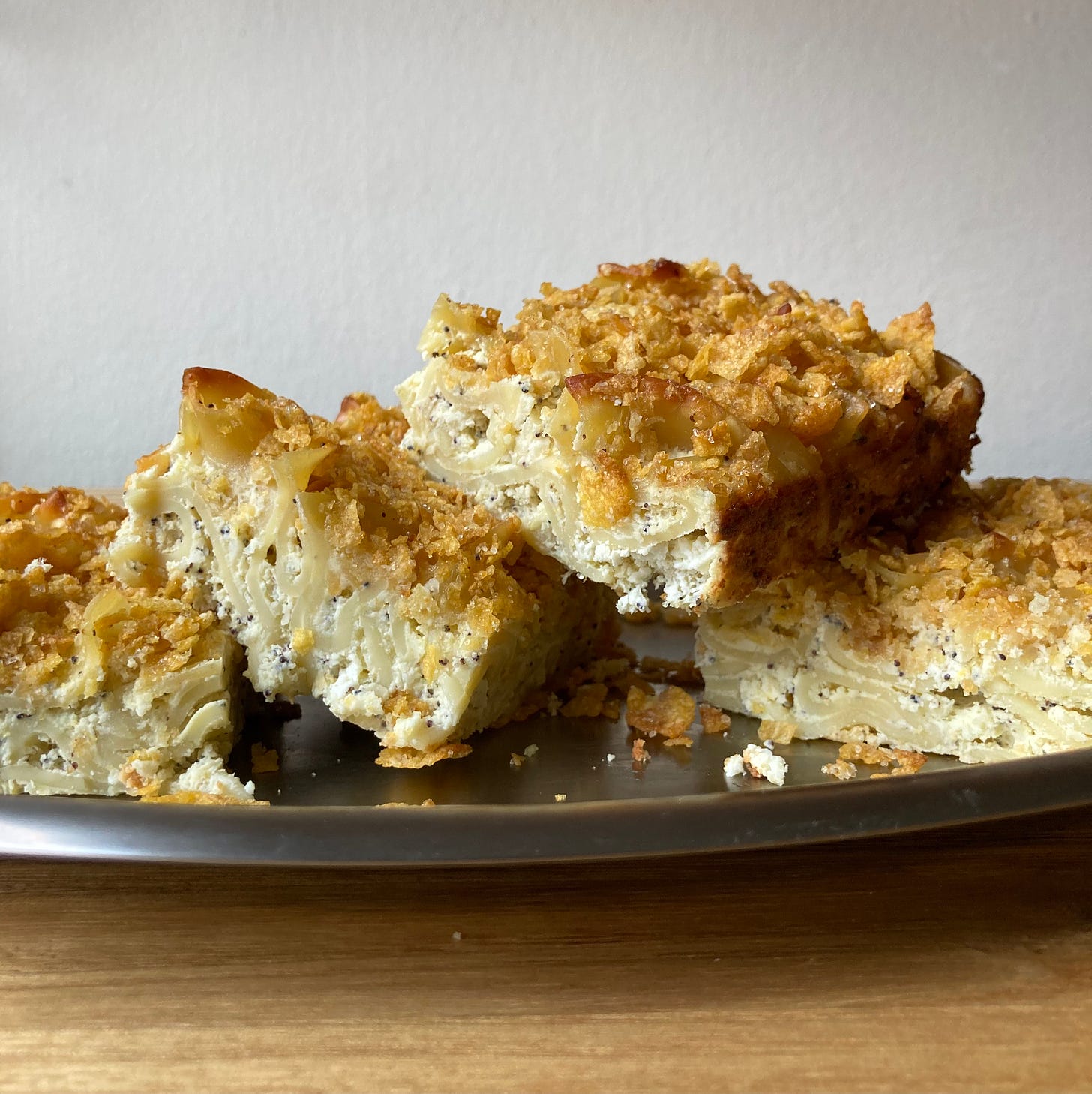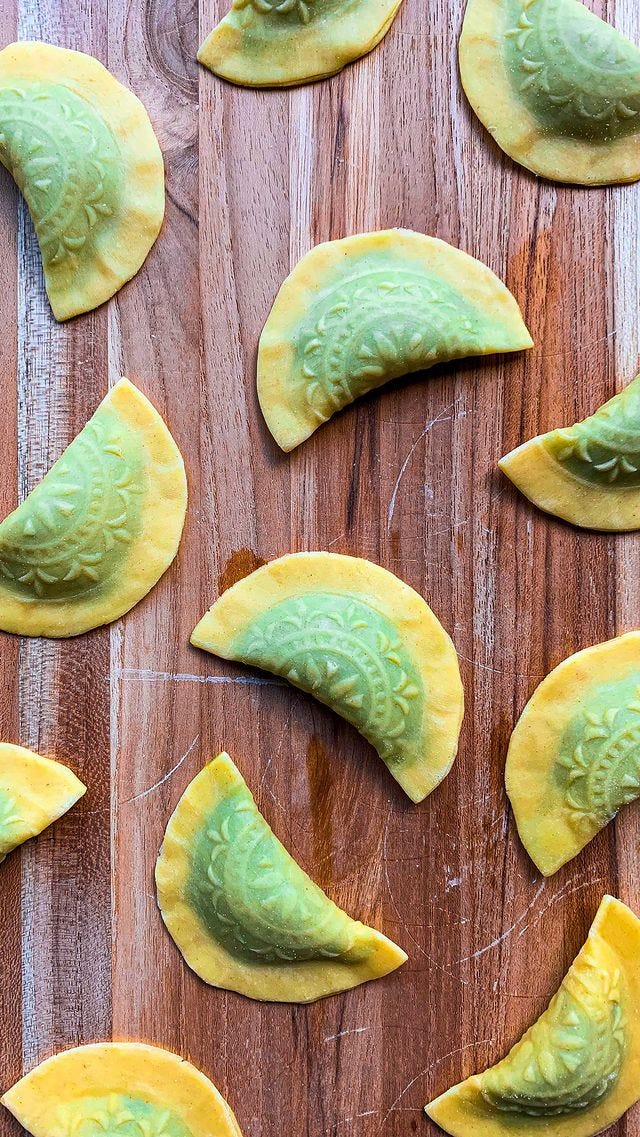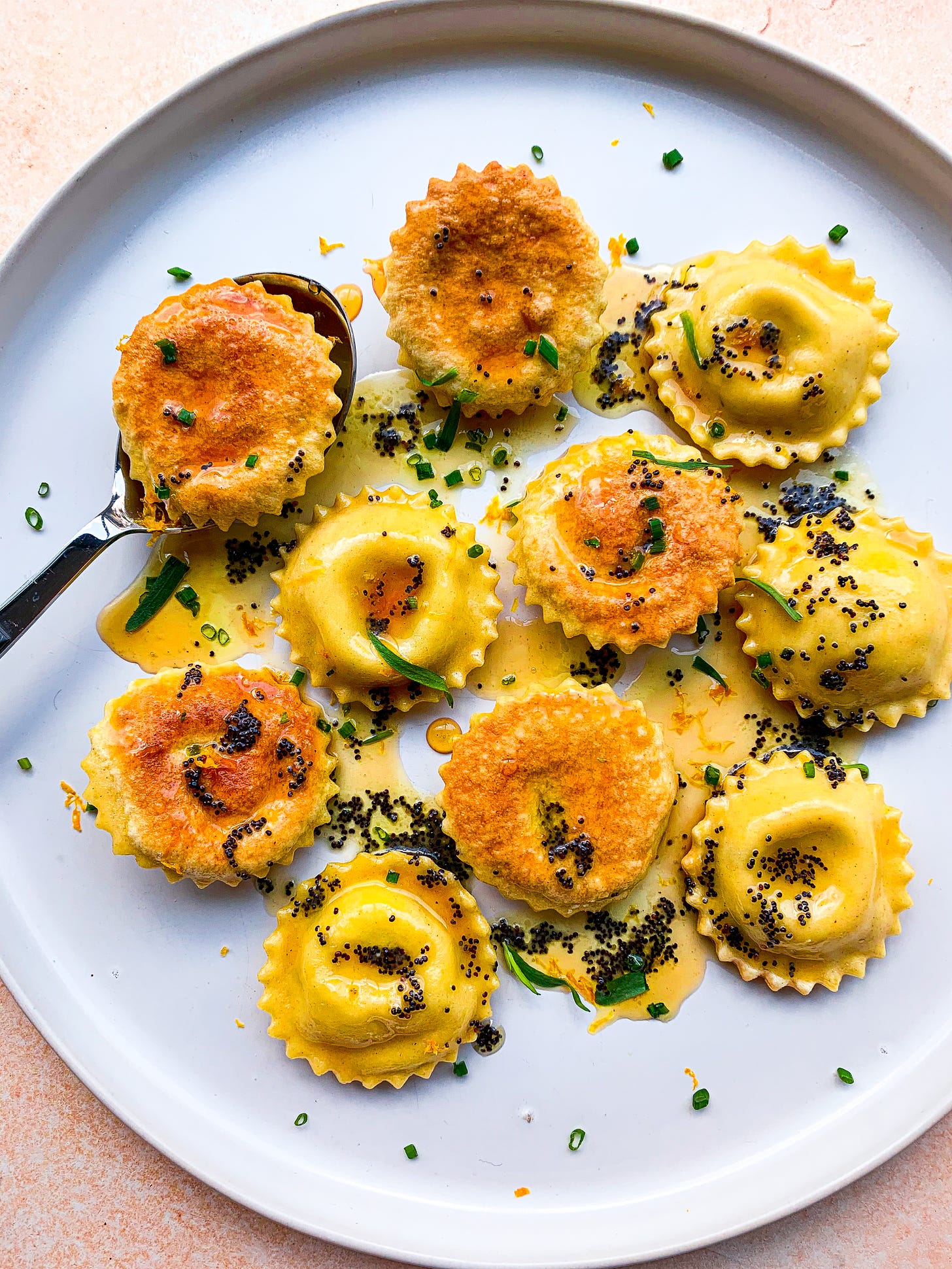

Discover more from The Jewish Table
*If you are receiving this newsletter for the second time, I apologize! I intended to send it to my entire list the first time around, but accidentally just sent it to paid subscribers. The only way to correct it was to rewrite/resend to everyone. More kugel for all! xx
Today is a very exciting day, folks. Because today I have two recipes for you: a lemon poppy seed kugel, which is my spin on the already indulgent classic, and a next-level, kugel-inspired recipe for crispy lemon poppy seed ravioli by Meryl Feinstein (more on Meryl and this week’s recipe collaboration below)!
For my gluten-free and/or dairy-free and/or vegan subscribers, next week’s newsletter has you covered, I promise. (If you haven’t yet subscribed to the weekly newsletter, you can do that here.) But this week, with Shavuot - aka the Jewish calendar’s celebration of all things dairy and wheat-y - arriving Sunday night, I am leaning in with a double dose of my favorite Ashkenazi comfort food.
Kugel is not really a dish, it is more like a tiny universe. The word refers to a category of related casseroles and baked puddings made from some form of starch (typically potatoes, noodles, bread, matzo, and occasionally rice) that are bound by egg and baked until deeply golden. Kugel’s ancestors date back to medieval Germany, when Jewish cooks began to add small flour dumplings to their Shabbat stews as a way of stretching the meal and creating a hearty side dish. (The dumplings were typically removed and served separately, alongside the stew.)
The concept spread across Central and Eastern Europe and, over time, the dumplings got placed into small ceramic vessels called kugeltopf and steamed on top of the stew. Eventually, kugels transformed into the standalone dish we know today.
My husband Yoshie is a ride or die potato kugel fan, but I skew toward the noodle end of the kugel spectrum. Lokshen (Yiddish for “noodle”) kugels, which tend to be sweet rather than savory, can be made without dairy, but are at their best enriched with sour cream, cottage or farmer’s cheese, butter, or ideally all three. As such, they are a decidedly decadent treat - what I describe to my kids as a “sometimes” food, rather than an all the time food. And Shavuot is definitely one of those times.
My riff on traditional lokshen kugel takes its cue from the lemon poppy seed muffins I loved as a kid in the 1990s, when they dominated virtually every coffee shop’s pastry case. Here, the citrusy hit of lemon zest cuts through the kugel’s rich custard, while the poppy seeds lend an earthy crunch. The sweet and crunchy topping, made from crushed Cornflakes (a hallmark of American-style noodle kugels), gilds the lily with a second hit of lemon zest. Often, when I develop a recipe for something sweet, I end up giving away or (regrettably) throwing away a decent portion of the leftovers. This lemon poppy seed kugel was gone in 72 hours.
The original idea came out of a brainstorming session with Meryl Feinstein. Meryl runs the wildly successful Pasta Social Club, which brings people together through the act of making handmade pasta. In addition to being a brilliant teacher, she is at once a master of her chosen craft, and a bona fide culinary artist. Every photo she posts on Instagram literally makes me gasp out loud. I mean just LOOK at these ramp pesto ravioli!
I originally reached out to Meryl (nervously, since I am such a big fan) to see if she might like to collaborate on a kugel recipe made with fresh egg noodles. But she worried that the extended baking time required to make a kugel might not be compatible with fresh pasta. So instead, she transformed the dish into a kugel-inspired ravioli filled with ricotta and mascarpone, and topped with a honey-lemon gastrique and butter-toasted poppy seeds. Yes. Please.
Meryl’s dish (photo and recipe below) is truly next-level and, true to form, visually stunning. The ravioli are definitely more labor intensive than my original kugel, but those willing to give it a shot will be rewarded handsomely. Thank you Meryl for the fun collaboration!
Lemon Poppy Seed Noodle Kugel
Recipe by: Leah Koenig
Serves 6
For the kugel:
1 tablespoon poppy seeds
8 oz extra-wide egg noodles (about 5 cups uncooked noodles)
2 tablespoons unsalted butter, melted
3 oz cream cheese, at room temperature
1 cup cottage cheese
¾ cup sour cream
3 eggs, lightly beaten
½ cup sugar
½ teaspoon kosher salt
1 ½ packed teaspoons finely grated lemon zest
1 ½ teaspoons vanilla extract
For the topping:
1 1/2 cups lightly crushed cornflakes
2 tablespoons sugar
3 tablespoons unsalted butter, softened
½ packed teaspoon lemon zest
Make the kugel: Preheat the oven to 350˚F (180˚C), and lightly grease an 8-inch square baking pan. Add the poppy seeds to a clean spice or coffee grinder and pulse for a few seconds, just to crack them open. (Do not pulse any longer, or they will turn to powder.) Set aside.
Bring a medium pot of water to a boil over high heat. Add the noodles and boil until just short of tender, 5-7 minutes. Drain and set aside.
In a stand mixer fit with a paddle attachment (or using a handheld electric mixer and a large bowl), beat together the melted butter, cream cheese, cottage cheese, sour cream, eggs, sugar, salt, lemon zest, and vanilla extract at low speed until smooth and combined. Add the cooked noodles and ground poppy seeds and stir to combine. Pour the mixture into the prepared baking dish and smooth top with a spatula.
Make the topping: Add the cornflakes, sugar, butter, and lemon zest to a medium bowl and, using clean hands, mix and press the ingredients together until the cornflakes are lightly coated with butter and sugar. (The cornflakes will crumble further, as you mix them.)
Sprinkle the cornflake mixture evenly over top of the kugel: Bake until the custard is set and the top is golden brown, with darker tips and edges, 40 to 50 minutes. Transfer to a wire rack to cool for about 20 minutes before slicing. Serve warm or at room temperature.
Crispy Lemon Poppy Seed Ravioli
Recipe by Meryl Feinstein of Pasta Social Club
Serves 4
For the dough:
300 grams (~2½ cups) ‘00’ or all-purpose flour
50 grams (~¼ cup) semola rimacinata or semolina flour*
200 grams (about 4 large) eggs, beaten
More semolina flour or cornmeal, for dusting
*If semolina or semola rimacinata flours are unavailable, use the same weight in ‘00’ or all-purpose flour.
For the filling:
250 grams (1 cup) whole milk ricotta
55 grams (¼ cup) mascarpone
Zest of 1 lemon
A generous grating of fresh nutmeg
5 grams (1-2) tablespoons minced chives
Salt, pepper, and lemon juice to taste
For the gastrique:
80g (¼ cup) honey
80 ml (⅓ cup) apple cider vinegar
60 ml (¼ cup) Meyer lemon juice (about 2 lemons)
Salt and pepper to taste
For finishing:
75 grams (⅓ cup; 5 tablespoons) unsalted butter
5 grams (1½ teaspoons) poppy seeds
Extra-virgin olive oil
Minced chives and tarragon, for garnish (optional)
Salt and pepper to taste
Make the pasta dough:
Make the pasta dough by hand according to the “well method” (see instructions here). Alternatively, add the flour and eggs to the bowl of a food processor with the steel blade attachment. Pulse until beads of dough start to form and come together, about 30 seconds. Transfer the mixture to a flat, ideally wooden surface and knead for 5 to 10 minutes until smooth and firm.
Wrap the dough tightly in plastic and allow it to rest at room temperature for about 30 minutes. While the dough rests, make the filling and the gastrique.
Make the filling:
Combine the cheeses, lemon zest, a small squeeze of lemon juice, nutmeg, and a generous pinch of salt and pepper in a food processor. Pulse until smooth and creamy. Adjust seasoning to taste.
Transfer to a bowl and fold in the minced chives. Cover with plastic wrap—or, if you have one, transfer the mixture to a piping bag—and refrigerate until ready to use.
Note: The filling can be made in advance and stored, tightly sealed, in the refrigerator for up to two days.
Make the gastrique:
In a small saucepan, cook the honey over medium-low until noticeably darkened in color, about 5 minutes.
Stir in the vinegar and Meyer lemon juice. Continue to cook, stirring occasionally, for 10 to 15 minutes until the mixture has reduced to the consistency of a thin syrup.
Season to taste with salt and pepper and set aside.
Note: The gastrique can be stored for up to two weeks in the refrigerator. Bring to room temperature or gently reheat before using. Pairs well with cheese, meats, and vegetables!
Assemble the ravioli:
You can make the ravioli into a variety of shapes. See my tutorials here, here, and here for some of my favorites.
Place the finished pasta in a single layer on a baking sheet lined with semolina flour, cornmeal or a dry dish cloth until ready to cook.
Note: The ravioli can be assembled in advance and frozen. To store them, freeze uncovered on the semolina-lined tray for about 25 minutes until solid. Then transfer to a freezer bag or airtight container and return to the freezer. When ready to cook, do so straight from frozen (no need to defrost).
Finish the dish:
Bring a large pot of water to a boil.
Meanwhile, add the poppy seeds to a small saucepan or skillet. Toast over medium heat, shaking the pan often, until fragrant, about 3 to 5 minutes. Remove from the heat.
When the water is boiling, salt it well. Shake off any excess flour from the ravioli and carefully drop them into water. Stir gently for a few seconds and cook until tender, about 2 to 3 minutes. Transfer the cooked ravioli with a slotted spoon to a paper towel-lined tray or plate. Save some of the pasta cooking water.
Add a thin layer of olive oil to a large non-stick pan and heat over medium-high. Arrange the boiled ravioli in a single layer and cook until the bottoms are golden and crispy, about 5 minutes. (You may need to do this in batches.)
While the ravioli are frying, gently reheat the gastrique to loosen. Then return the pan with the poppy seeds to medium heat and swirl in the butter. When the butter has melted, add a splash of the pasta cooking water and stir the mixture constantly to emulsify. Simmer briefly until slightly thickened and season to taste.
Divide the ravioli among plates or arrange on a platter. Drizzle generously with the poppy seed butter sauce, followed by a lighter drizzle of the gastrique (a little can go a long way!). Garnish with chopped chives and tarragon, if desired.
Subscribe to The Jewish Table
recipes + stories from the world of jewish food, by leah koenig










Hi! Can any of the kugel be made in advance? Thinking for break fast. Thanks!